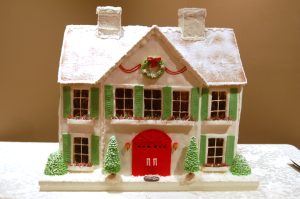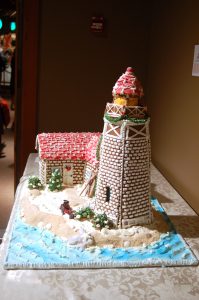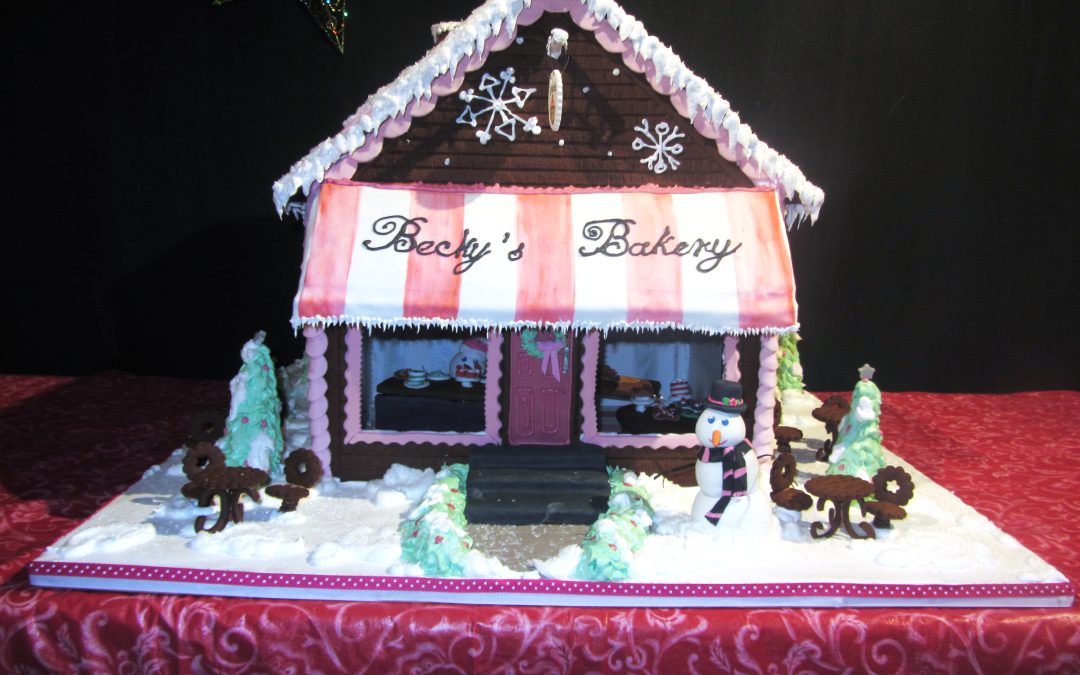By GAIL BLAKELY
One of the most popular Christmas decorations is the gingerbread house. Quite simply, it is a model house made of gingerbread, most often decorated with a variety of candies and icing. Usually they are built by children with the help of their parents or other industrious family members.
Most families have fond memories of creating gingerbread houses together; some go on to tell the tale of how the family dog got into the act and devoured most of the sculpture while the family slept. Others have stories about cats who were a bit disgruntled by all the noise and visitors (read that as interlopers), and chose to retreat to a dark and quiet spot, such as under the roof of the family’s gingerbread creation.
 The honey cakes of ancient Rome may be the precursor to today’s gingerbread house. Food historians agree that ginger has been used in food and drink since antiquity, but it is believed that gingerbread, as we know it, was first baked in Europe at the end of the 11th century. That was when returning crusaders brought the custom of a spicy bread from the Middle East. Ginger was not just utilized for its taste—it also has preservative properties that kept the bread from going stale
The honey cakes of ancient Rome may be the precursor to today’s gingerbread house. Food historians agree that ginger has been used in food and drink since antiquity, but it is believed that gingerbread, as we know it, was first baked in Europe at the end of the 11th century. That was when returning crusaders brought the custom of a spicy bread from the Middle East. Ginger was not just utilized for its taste—it also has preservative properties that kept the bread from going stale
A variety of cultures lay claim to the baking of gingerbread. According to French legend, gingerbread was brought to Europe in 992 by an Armenian monk who taught gingerbread cooking to priests and other Christians.
The gingerbread we know today descends from medieval European culinary traditions. It was shaped into various forms by monks in Germany in the 13th century. Lebkuchen bakers supposedly went on record in 1395 as stating that Nuremberg was the recognized “Gingerbread Capital of the World.” It was at this time that master bakers and skilled workers began to create complicated works of art from gingerbread.
The custom spread across Europe, with Swedish nuns baking gingerbread to ease digestion. It was sweetened with honey and flavored with ginger, cinnamon, cloves, nutmeg, and cardamom. Medieval bakers used carved boards to create elaborate designs, and soon, in the 15th century, figure-shaped gingerbread biscuits became popular. The first documentation of these is from the court of Elizabeth I of England, who had gingerbread figures made in the likeness of some of her important guests.
Suffice it to say that gingerbread has been a familiar food in various forms for a very long time. Sometimes it is served as a soft, delicately spiced cake, sometimes as steamy, dark squares of bread accompanied by fresh butter, whipped cream, or lemon sauce. Sometimes it is dense, sometimes light, sometimes sweet, other times spicy.
 But gingerbread houses are really the domain of the master bakers, the Lebkuchler. They perfected the large pieces of lebkuchen, which are used to build Hexenhaeusle (witches’ houses from the fairy tale of Hansel and Gretel). This pastry had the nickname “pepper sack,” because the bakers packed all their available spices into their product—cardamom, cloves, cinnamon, white pepper, anise, and ginger.
But gingerbread houses are really the domain of the master bakers, the Lebkuchler. They perfected the large pieces of lebkuchen, which are used to build Hexenhaeusle (witches’ houses from the fairy tale of Hansel and Gretel). This pastry had the nickname “pepper sack,” because the bakers packed all their available spices into their product—cardamom, cloves, cinnamon, white pepper, anise, and ginger.
It was during the 19th century that gingerbread became both modernized and romanticized. The Grimm brothers’ fairy tale tells about two children who were abandoned in the woods by their destitute parents, only to discover a house made of bread, cake and candies. By the end of the century an opera had been written about the story, and the rest, as they say, is history.
At Christmastime, gingerbread makes its most opulent and impressive appearance. It is here in North America that elaborate Victorian houses, heavy with candy and sugar icicles, are the focus of many a family’s holiday preparations. However, one must remember that the gingerbread house that Hansel and Gretel discovered was no more than a rustic cottage, albeit decorated with candies and other sugary confections.
Nowadays our gingerbread is heavy with molasses in the South; here in New England we tend to add some maple syrup. Regional variations abound, and it is believed that nowhere else in the world is there a greater repertoire of gingerbread recipes than in America. This is because we have so many choices of ingredients, baking aids, and decorative items.
Gingerbread exhibits abound during the month of December, and none is more popular than the traditional display at Heritage Museums & Gardens in Sandwich. Gardens Aglow (opening November 27) is an annual event that has become a favorite holiday tradition for many Cape Cod residents. The spectacle of lights features, amongst other attractions, nine miles of holiday lights, a model train exhibit, rides on the vintage carousel, marshmallow roasts—and, of course, the highly anticipated gingerbread house display.
The museum staff graciously sent photos of gingerbread houses from past exhibits. Should they inspire you to attempt your own, there are numerous references online for such a project, as well as a variety of books and pamphlets. Here is a set of directions adapted from Beatrice Ojakangas by the Television Food Network. It’s quite basic, but will get you started ,should you want to give it a try.
Gingerbread House
For the house:
1/2 c butter, at room temperature,
1/2 c dark brown sugar,
1/4 cup light molasses or dark corn syrup,
1 TBSP each: cinnamon and ginger
1 1/2 teaspoon ground clove
1 tsp baking sod
2 cups AP flour
2 TBSP water
For assemblage and decoration:
Melted white chocolate
Gumdrops, licorice, peppermint, and other assorted holiday candies
Gingerbread House:
In a large mixing bowl, cream the butter, brown sugar, molasses, cinnamon, ginger, cloves and baking soda together until the mixture is smooth. Blend in the flour and water to make a stiff dough. Chill at least 30 minutes or until firm.
Preheat oven to 375°F.
Cut out the following paper patterns for the gingerbread house template:
Two rectangles, 3-by-5 inches, to make the front and back of the house. Two rectangles, 3-by-5 1/2 inches for the roof. Two pieces for the ends of the house, 3 inches wide at the base, 3 inches to the roof line, and slanted to a peak 5 1/2 inches from the bottom. Four smaller rectangles, 1 1/2-by-1 inch for the roof and sides of the entryway. And one piece, 2 inches wide at the base, 1 1/2 inches to the roof line, and slanted to a peak 2 1/2 inches from the bottom for the front of the entryway.
Roll gingerbread dough out to edges on a large, rimless cookie sheet. Place paper patterns onto the rolled out dough. With a sharp, straight edged knife, cut around each of the pieces, but leave pieces in place. Bake in the preheated oven for about 15 minutes until dough feels firm; remove and place the patterns on top of the gingerbread again and trim shapes, cutting edges with a straight-edged sharp knife. Leave to cool on baking sheet.
Assembly:
Melt the white chocolate according to package directions in a microwave and place in a heavy plastic bag; cut the tip off the bottom and pipe on the decorations you want for your house (windows, door, et cetera). Let dry until hardened; melt more chocolate and glue the sides, front and back of the house together at the corners, using the chocolate as glue (place an object against the pieces to prop up until the chocolate is dry). Glue the two roof pieces to the pitched roofline of the house. Then, similarly, glue the sides and roof of the entryway together with melted chocolate; attach the entryway to the front of the house. Continue decorating the house, using the melted chocolate as glue for gumdrops, licorice and peppermint, as desired.

